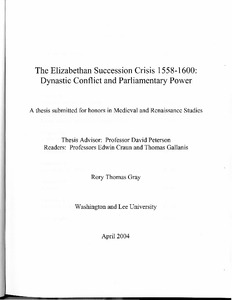| dc.rights.license | In Copyright | en_US |
| dc.creator | Gray, Rory Thomas | |
| dc.date.accessioned | 2023-10-20T18:01:20Z | |
| dc.date.available | 2023-10-20T18:01:20Z | |
| dc.date.created | 2004 | |
| dc.identifier | WLURG038_Gray_thesis_2004 | |
| dc.identifier.uri | https://dspace.wlu.edu/handle/11021/36509 | |
| dc.description.abstract | It is not generally known that a crisis surrounding the succession to the English throne occurred during Elizabeth I's reign (1558-1603). The overwhelming majority of historians of the
Elizabethan period, in fact, do not indicate that a succession debate existed at all. The few who do conclude far too easily that although Englishmen worried about the identity of Elizabeth I's successor, James I (1603-1625) was the only plausible candidate for the crown. Contemporary concerns are dismissed as having been unwarranted, and Elizabeth I is often vaguely assumed to have had matters fully under control. A retrospective view of history, which shows that James VI did in fact succeed, as well as a habitual deference to Elizabeth's greatness, has thus obscured the succession issue for a long time. . . . Every aspect ofmy research into this long neglected succession struggle reveals how deeply it was embedded in the political, diplomatic, ideological, and social fabric of the Elizabethan age. Rooted in the division of religious and foreign allegiances in sixteenth-century England, the divergence of English opinion on the identity of Elizabeth's legitimate successor fundamentally affected politics at the highest levels. No foreign or domestic faction was ignorant of the sweeping influence this determination would have upon England's future and each tried to arrange a settlement to suit its own self-interested ends. Elizabeth herself was heavily affected by the subject and it greatly influenced her often tenuous regime. Parliament was brought into play because of the great public consternation resulting from the queen's adamant refusal to name a successor. Radical ideologies were developed as a result, in order to support Parliamentary power to resolve this pressing matter, which ultimately challenged the
supremacy of the crown in English political life. Nor was the influence of the succession limited to the inspiration of new ideas in the political sphere. It also had a distinct impact on literary and theatrical works often associated with the Inns of Court. No complete understanding of the Elizabethan era, or of the later difficulties of Stuart rule, is possible without recognizing the foundational importance of the conflict over who would succeed Elizabeth I on England's throne. [From Introduction] | en_US |
| dc.format.extent | 96 pages | en_US |
| dc.language.iso | en_US | en_US |
| dc.rights | This material is made available for use in research, teaching, and private study, pursuant to U.S. Copyright law. The user assumes full responsibility for any use of the materials, including but not limited to, infringement of copyright and publication rights of reproduced materials. Any materials used should be fully credited with the source. | en_US |
| dc.rights.uri | http://rightsstatements.org/vocab/InC/1.0/ | en_US |
| dc.subject.other | Washington and Lee University -- Honors in Medieval and Renaissance Studies | en_US |
| dc.title | The Elizabethan Succession Crisis 1558-1600: Dynastic Conflict and Parliamentary Power | en_US |
| dc.type | Text | en_US |
| dcterms.isPartOf | WLURG038 - Student Papers | en_US |
| dc.rights.holder | Gray, Rory Thomas | en_US |
| dc.subject.fast | Elizabeth I, Queen of England, 1533-1603 | en_US |
| dc.subject.fast | Great Britain | en_US |
| dc.subject.fast | Kings and rulers -- Sucession | en_US |
| local.department | Medieval and Renaissance Studies | en_US |
